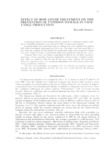Experiments aimed at developing effective methods to minimize typhoon damage in vegetable production were started in 1983, in Ogasawara islands.
Creeping melon was cultivated with or without row cover during the typhoon 8422 with a maximum wind speed of 47.0 m/sec. The fruits were harvested 30 to 45 days after the typhoon hit the islands. No marketable fruits were produced without row cover while 12.5 t/ha of marketable fruits were produced with the row cover.
Typhoon 8512 with a maximum wind speed of 34.6 m/sec hit fields planted to Santousai (a leafy vegetable, Brassica campestris) at harvest time. A higher marketable yield was obtained with the use of row cover than without the treatment. However, continuous row cover treatments throughout the cultivation period resulted in a significant yield loss.
The row cover technique was found to be very effective in reducing typhoon damage, but the mechanism whereby the row cover could alleviate the damage remains to be elucidated.

